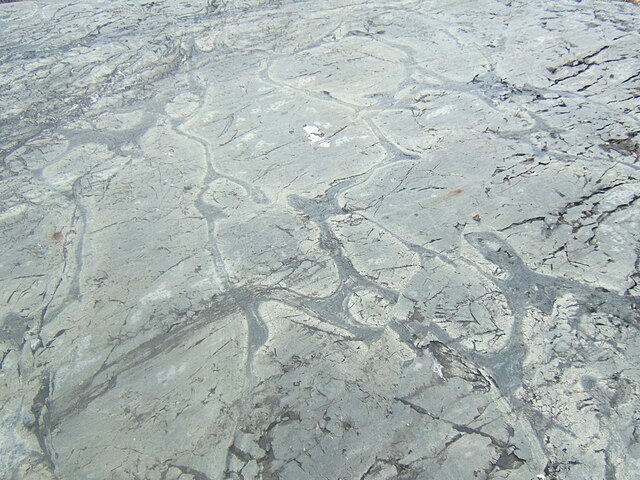The Canadian Shield, also called the Laurentian Shield or the Laurentian Plateau, is a geologic shield, a large area of exposed Precambrian igneous and high-grade metamorphic rocks. It forms the North American Craton, the ancient geologic core of the North American continent. Glaciation has left the area with only a thin layer of soil, through which exposures of igneous bedrock resulting from its long volcanic history are frequently visible. As a deep, common, joined bedrock region in eastern and central Canada, the shield stretches north from the Great Lakes to the Arctic Ocean, covering over half of Canada and most of Greenland; it also extends south into the northern reaches of the continental United States.
Panorama of Canadian Shield geography in the Flin Flon, Manitoba, region. Big Island Lake is in the background.
Weathered Precambrian pillow lava in the Temagami Greenstone Belt
Folded Precambrian gneiss of the Canadian Shield in Georgian Bay, Ontario
Typical Canadian Shield landscape: spruce, lakes, bogs, and rock
The Precambrian is the earliest part of Earth's history, set before the current Phanerozoic Eon. The Precambrian is so named because it preceded the Cambrian, the first period of the Phanerozoic Eon, which is named after Cambria, the Latinised name for Wales, where rocks from this age were first studied. The Precambrian accounts for 88% of the Earth's geologic time.
Weathered Precambrian pillow lava in the Temagami Greenstone Belt of the Canadian Shield
Landmass positions near the end of the Precambrian[citation needed]





![Landmass positions near the end of the Precambrian[citation needed]](https://upload.wikimedia.org/wikipedia/commons/thumb/2/22/Positions_of_ancient_continents%2C_550_million_years_ago.jpg/600px-Positions_of_ancient_continents%2C_550_million_years_ago.jpg)